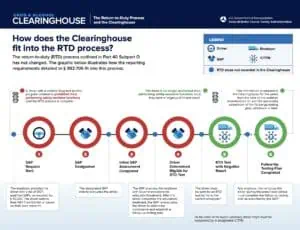By ASAP Staff
The FMCSA’s Clearinghouse II is set to take effect on November 18, 2024, bringing significant changes to how a commercial driver’s license (CDL) is managed for drivers with a “prohibited” status in the Clearinghouse. While the Return-to-Duty (RTD) process itself remains unchanged, the new regulations now require that a driver’s CDL be downgraded or revoked if they have a “prohibited” status, making the completion of the RTD process essential to restoring their commercial driving privileges.
Here’s what drivers need to know to move from “Red” (prohibited status) to “Green” (back to work) in the Clearinghouse.
The Return-to-Duty Process and Clearinghouse II
Drivers who fail, refuse a DOT drug and/or alcohol test, or have a DOT violation are placed in “Red” status in the Clearinghouse, prohibiting them from performing safety-sensitive duties. Under the new Clearinghouse II rule, this prohibited status now requires State Driver Licensing Agencies (SDLAs) to downgrade or revoke the driver’s CDL until they complete the RTD process, making it a critical step for drivers to maintain or regain their CDL. The RTD process remains the same and this process has always been required, but now if the driver fails to complete the process, there are actionable consequences.
Here are the steps drivers must follow to move from Red to Green:
- SAP Request Sent – The employer provides the driver with a list of qualified Substance Abuse Professionals (SAPs), as required by § 40.287. The driver selects a DOT qualified SAP and begins the evaluation process.
- SAP Designated – The SAP conducts an initial evaluation, determining the necessary education and/or treatment for the driver.
- Initial SAP Assessment Completed – After the initial assessment, the SAP provides recommendations for education and/or treatment. The driver must complete these recommendations, after which the SAP will reassess the driver to confirm compliance and develop a follow-up testing plan.
- Driver Determined Eligible for RTD Test – Once the SAP clears the driver for the RTD test, the employer schedules the test. The RTD test supersedes a pre-employment test as an employer tip managing a DOT program. For owner-operators, this is handled by a designated third-party administrator (C/TPA). FMCSA has provided clarity on who can test a driver for their RTD test if an employer is not involved.
- RTD Test with Negative Result – Upon receiving a negative result from the RTD test, the driver is allowed to return to performing safety-sensitive duties and can return to work. The employer or C/TPA enters the negative RTD date into the Clearinghouse turning the driver’s status from “Red” to “Green”.
- Follow-Up Testing Plan Completed – The SAP’s follow-up testing plan (number of tests, duration of the follow-up tests, remember these must be a minimum of 6 tests in 1 year and may last up to 60 months) is critical. Any employer that hires the driver during this period must ensure completion of the follow-up tests. Upon a successful follow-up test plan all being negative, the employer enters the date of the last negative test into the Clearinghouse. The driver’s Clearinghouse record will remain in the database for five years from the entry of that last follow-up test date.
(Reminder: Both Follow-up and Return-to-duty tests are to be conducted under direct observation. This process is outlined in §49 CFR Part 40.67 or found at https://www.transportation.gov/sites/dot.gov/files/docs/ODAPC%20DOTs_Direct_Observation_Procedures_Instruction_Sheet_August312009.pdf)
The Urgency of Taking Action: Avoid License Downgrades
Starting November 18, 2024, drivers in “prohibited” status will have their CDL downgraded or revoked by their state’s SDLA unless they complete the RTD process. Acting now to complete the RTD process before this deadline is critical to preventing disruptions to a driver’s commercial driving privileges.
SAPs play a pivotal role as the ‘gatekeeper’ to the RTD process, as they are responsible for assessing drivers, recommending necessary education and/or treatment, and determining whether a driver is eligible to return to duty. Without the approval of a qualified DOT SAP, drivers cannot progress through the RTD process or regain their CDL. SAPs not only ensure compliance with DOT regulations but also safeguard public safety by ensuring that only drivers who have successfully completed the required steps are allowed back behind the wheel.

image 1: Federal Motor Carrier Safety Administration, FMCSA. (n.d.). Drug & Alcohol Clearing House. FMCSA. “CDL Downgrades FAQ.” FMCSA Clearinghouse. https://clearinghouse.fmcsa.dot.gov/FAQ/Topics/CDL-Downgrades [November 21, 2023]. U.S. Department of Transportation. “Back to Basics’ for Substance Abuse Professionals.” Office of Drug and Alcohol Policy & Compliance. https://www.transportation.gov/odapc/back_to_basics/SAP [October 13, 2023]. the U.S. Department of Transportation Federal Motor Carrier Safety Administration. “The Return to Duty Process in the Clearinghouse.” Drug and Alcohol Clearing House. https://clearinghouse.fmcsa.dot.gov/Resource/Index/RTD-Infographic [n.d.]. https://clearinghouse.fmcsa.dot.gov/Resource/Index/RTD-Infographic
FMCSA. “CDL Downgrades FAQ.” FMCSA Clearinghouse. https://clearinghouse.fmcsa.dot.gov/FAQ/Topics/CDL-Downgrades [November 21, 2023].
U.S. Department of Transportation. “Back to Basics’ for Substance Abuse Professionals.” Office of Drug and Alcohol Policy & Compliance. https://www.transportation.gov/odapc/back_to_basics/SAP [October 13, 2023].
The U.S. Department of Transportation Federal Motor Carrier Safety Administration. “The Return to Duty Process in the Clearinghouse.” Drug and Alcohol Clearing House. https://clearinghouse.fmcsa.dot.gov/Resource/Index/RTD-Infographic [n.d.].
SHARE:
ASAP has a nationwide reach in all 50 states and U.S. territories. Our trained and knowledgeable team will assist you in understanding the process and signing up. It’s fast and easy to enroll with ASAP! 888.792.2727 x607


